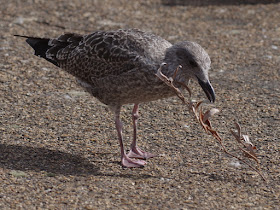The three chicks at the east end of the island were in the water as they were transferred from one parent to another.
They were soon back up on the other parent's back and being fed.
The youngest of the three is so tiny that even the little ripples on the lake seem like Atlantic rollers to it.
Thanks to the people at Bluebird Boats for taking me out to see them.
The Moorhens in the Dell have had a difficult year, with their nests constantly being destroyed, in one case by a Mallard squatting on it. But finally, at the end of August, they have managed to produce three chicks.
The Moorhens in the willow near the bridge also have at least one new chick. The nest is in a hole in the tree, invisible from the ground, and is used every year.
Only a couple of weeks ago the new chick in the Italian Garden was a little black ball of fluff with ridiculously large feet like the one above. Now it's medium sized. It was inside one of the planters, and must have climbed up the net to get in, something that Moorhens can do at an early age.
A pair of Gadwalls cruised past Peter Pan.
A Cormorant near the bridge, in a place teeming with fish, was washing when it saw one, promptly ate it, and went on washing.
Two Herons fought about a place on a post. There was a perfectly good unoccupied post nest to it.
A young Lesser Black-Backed Gull amused itself by throwing a twig about.
The familiar female Kestrel perched on a tree on Buck Hill and looked around keenly for any sign of prey.
A Coal Tit in the shrubbery in the Rose Garden picked at a sunflower seed it had got out of the feeder.
A young Blue Tit was just getting blue feathers on its head to replace the juvenile grey ones.
To complete the set, a Great Tit near the bridge waiting to be fed.
A Common Darter dragonfly used a stone ledge in the Italian Garden as a base from which to fly out and catch passing midges.
When the molluscs whose shells are preserved in the Portland limestone were alive 150 million years ago, there had already been dragonflies on earth for 175 million years.












Really attractive photo of the male Common Darter against the stonework.
ReplyDeleteIt was taken vertically downwards, leaning over the edge of the parapet.
ReplyDelete